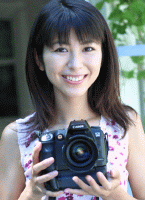EOS D60 impressions
|
By Hitoshi Doi (doi@usagi.org)
Some of my thoughts on the EOS D60 are as follows.
|
![[Nagai Nobuko]](../../seiyuu/images/ind/n-nobuko/non0208-1129.gif)
|
Revision 0.8 (2002.09.01) Revision 0.9 (2002.11.30) Revision 1.0 (2003.03.10) |

|
In general, I like the D60 so far, and I don't feel like using
the D30 any more. But I did take almost 11000 pictures with the D30 in
8 months, so I feel like I got my money's worth.
From now on, I'll bring both the D60 and D30 to the events,
so I can take pictures while the buffer is being written out,
and so that I don't lose time when changing lenses.
But the D60 is definitely my main camera.
The D60 body is basically the same as the D30, so most of the non-digital portions are the same. |
AF (auto focus)
Canon says that the D60's AF has been improved. Of course, I don't see how one can get worse than the D30, and still be called an "AF" camera. (^_^;I have only used the D60 at one "dark" event so far, but the AF does seem to be much faster and "slightly" more accurate than the D30. The red hilighting of the focusing point is very nice too.
[updated 2002.11.30]
Overall the D60 responds much better than the D30 at indoor events
(using stage lights, even bad stage lights).
But it still can't focus when it's really, really dark
(using the EF28mm F1.8 lens).
ISO
The D30 can go up to ISO 1600, but the D60 can only go to ISO 1000. Slight disadvantage for the D60, but ISO 1000 is enough for the dark events. Even if a higher ISO option was available, the resulting JPEG might be too noisy (grainy).
buffering
The D60 has a different buffering mechanism from the D30. The D30 seemed to put the JPEGs in the buffer, allowing for very dynamic use of the buffer. So depending on the size of the JPEG, the buffer can hold between 8 to 15 (or even more) images. But the D60 seems to put the RAW data in the buffer, which means that it can only hold 8 images. So the D60 fills up after 8 shots.However it also seems that the D60 has a secondary cache/buffer for writing the data to the CF (when using JPEG mode). The buffer for the RAW data empties out faster than the data is written to the CF. So it's possible to take pictures even though the data isn't completely written out to the CF.
In normal use, the D60 is faster than the D30 and I can take more pictures in the same time frame. But writing out the data to the CF takes longer, as each image file is about twice as big.
I did some simple performance tests on the D60 (and 10D).
illuminated display
The D60's display at the top right of the camera can be illuminated by pushing the "set" button. This is very convenient when trying to look at some of the numbers on the display during dark events.
buffer remaining display
In the view finder, the D60 tells you how many slots are left in the 8 shot buffer. This is very useful for pacing the shots, as I don't want to get caught with 0 slots left in an important situation.
jpegs
The D60 jpegs (with all of the parameters set to the default values) look much sharper than the D30 jpegs.
[HD's digital cameras]